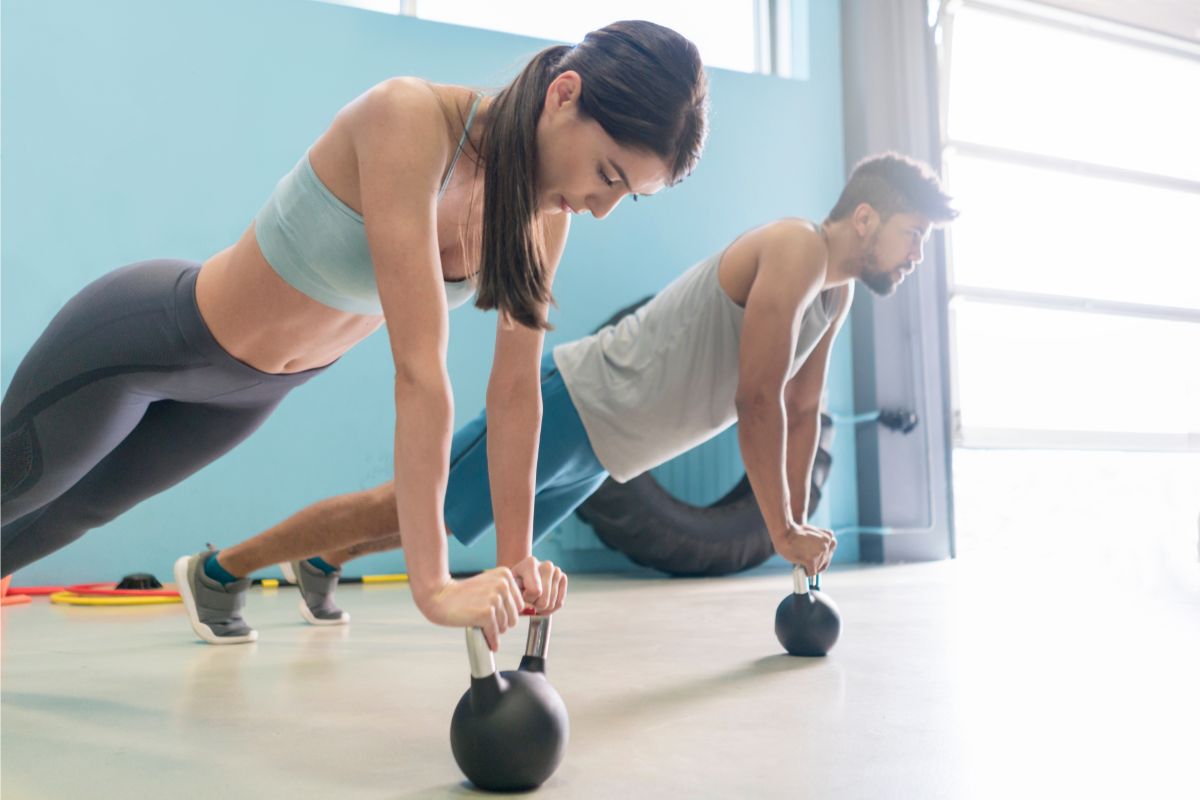If you’ve ever watched a sprint race then you have probably seen a block start.
When getting into sprint racing they can seem confusing, if you don’t know how to set one up or what they’re actually doing for your time.

In reality they won’t cut your time down by seconds but if used right you can lose a couple milliseconds and sometimes that’s all you need. The key to a great race is a great start.
In this article we describe what a block start is and how to efficiently use one.
If you still aren’t confident enough to use one by the end of it then don’t worry, we also have some starting positions that don’t use starting blocks.
Everyone begins their sprinting journey differently so take things at your own pace in order to build your pace.
What Are Block Starts?
A starting block will typically come in 3 sections, a spine and two foot blocks. The spine is the long part that sticks into the ground and the foot blocks attach to either side of it.
The spine sticks into the ground with small spikes so be careful when handling.
The benefit of having detachable foot blocks is that some people’s feet will be farther apart, or their dominant foot will be different to yours.
Not all block starts have detachable feet however, some have them attached but they can slide into place.
This gives the same access as detachable foot blocks but they may be harder to store.
A block start is generally used in 400m races or shorter lengths. This is because it provides a quick start, whereas long distance runners aren’t looking for a super quick start but instead a steady pace.
History Of Starting Blocks
The creation of starting blocks can be credited to Australian athlete Charlie Booth and his father in 1929, meaning they didn’t appear in the first modern Olympics.
Before the starting block they would be provided with a trowel and would dig holes in the ground to put their feet into.
Of course this was destructive to the track and wasn’t regulation as everyone liked their holes to be different depths.
One year after creation, George Simpson used starting blocks and set a new record time in the 100 yard dash as 9.4 seconds.
Due to his use of equipment the IAAF didn’t recognise it as an official record but it did show that start blocks could be beneficial.
It wasn’t until 1948 for the starting block to be used in the Olympics.
Even then some old fashioned runners were digging their own holes until the late 1970s.
How To Set Them Up?

The first thing you need to do is find your kicking foot or quick-side foot. This may take some trial and error.
Time your take off from each foot to see which allows for the fastest start.
Another way to test is to have someone stand behind you and lightly push you. Whichever foot you step onto to catch yourself is the quick-side foot.
When setting up a starting block most instructors will teach you the 1-2-3 method:
- One foot distance from the starting line is where the spine should be placed. It can be straight or at an angle if the race has a curve early and you need to aim toward the inner lane to start straight. You’ll stand on either end to lock it into the ground.
- Measure two feet distance from the starting line for where your front block should be placed. The angle of the front block will vary for what’s comfortable for you, we recommend the third notch from the top.
- Finally, the back block should be placed about three feet distance from the starting line. You want the angle of the back block to be as high as possible while remaining comfortable, probably about the first or second notch from the top. The back block is where your kicking/quick-side foot is placed.
When you have it all set up then check that it is stable and won’t slide. Now is also where you can adjust angles accordingly.
You might find after a few uses that you may need to change up how you measure your spaces which is okay.
Not everyone’s foot size matches well with your height and what works for someone with your shoe size might not work for you because they’re shorter. In the end it’s all a matter of preference.
You will spot numbers on either side of the spine. These are to help you remember where you placed your blocks so you can set up quicker next time.
It is important to create a routine when setting up your starting block for a race.
Having a pre-race routine will help you get in the right mindset.
This routine doesn’t have to just include setting up your blocks. It could also be some set warm up or releasing tension through shouting, whatever you need to clear your head.
The warm ups in your routine need to be dynamic stretches rather than static stretches.
Static stretches are where you hold one stretched position for an extended period of time, these can be detrimental to someone about to do a sprint.
These kinds of stretches should be reserved for cool down routines to avoid injury. Dynamic stretches involve movement like lunges, twists and squats.
Most athletes will strongly encourage you to include tuck jumps to the end of your routine.
It’s warming up your muscles to act like a spring and get into a rhythm which is what you want to create an explosive start. Don’t let your muscles have time to tighten up.
‘On Your Marks’ Position
- Get into a crouching position and back up into the starting block.
- Place your feet on the blocks with your kicking foot on the back one. Try not to have your toes touch the ground.
- Your hands should be placed in front of you about a shoulder width apart. Your shoulders should be slightly over the starting line and your arms shouldn’t be bent. Place your hand just shy of the starting line and form a high bridge with your thumb and fingers.
- Don’t have your hands closer than a shoulder width apart, the goal is to be low to the ground. You can go farther apart to get lower and build more power, but you need to be extremely strong to execute this. If your arms are too close together there is a chance that your legs will collide with them on take off.
If you aren’t happy with any conditions then you can recall the start of the race without calling a false start.
This must be called before the announcer calls ‘set’. Don’t do this without a valid reason as it can lead to a yellow card if the announcer deems it invalid.
‘Set’ Position
- Lift your hips until they are just higher than your shoulders. Don’t completely straighten the back leg as it won’t be able to generate as much power.
- The front leg should be bent at a 90 degree angle, while the back leg should be about a 120 degree angle.
- Transfer your weight onto the front foot. Breathe in and hold your breath.
‘Go!’
- Exhale and drive your arms forward.
- Bring your back leg forward into a high knee, you want a straight line through your head to the heel of your front leg.
- Remember to run out of blocks, don’t step or jump.
When Running

Now that you have a good start you just need to focus on the running part of the race.
From the starting block you should aim to drive for the first 10m, you can shorten this distance based on your acceleration.
From around the 10m mark to the 30m mark you should be straightening yourself into an upright position. At this point you should’ve reached your full velocity.
When running try to keep your face and hands relaxed. Make sure you also run on the balls or toes of your foot rather than the heel.
It may seem obvious but try to keep your eyes on your track, the outside world is distracting and can take you out of the mindset you worked so hard to get into.
You can take in the cheers and crowd applause when you finish the race.
How Can They Help?
By getting into a starting block position you are essentially preloading your muscles into their desired position.
By preparing your muscles it will give you optimal horizontal force. It will also allow you to start accelerating before your opponents if done effectively.
When it comes to sprinting, proper acceleration is what separates the fastest runners from the winning runners.
You can get up to incredible speeds but if it takes you a while then maybe short distance running isn’t for you.
2 Point Start, 3 Point Start And 4 Point Start
We don’t recommend starting your sprinting journey on block starts. They could do more harm than good if you don’t know how to take off properly.
Here are some starting positions that don’t use block starts to help you build your skills.
2 Point Start
- This is also known as a standing start.
- Place your front foot just behind the starting line.
- Your feet should be about shoulder length apart, then split your feet. You can adjust slightly here for better balance.
- At ‘set’ bend your hips and put your weight onto the front foot. You want to keep your head and spine neutral.
- Split your arms so they’re opposite to your feet, e.g. right foot forward means left arm forward.
3 Point Start
- Measure about 2 feet lengths from the starting line.
- Put your strong leg forward and your quick leg behind.
- Kneel down so that the knee of the back leg is touching the ground. This knee should be in front of your front foot.
- Whichever foot is forward then the opposite hand should be on the start line, e.g. right foot is forward so left hand is just before the starting line.
- Your other hand should be on the side of your body.
- At ‘set’ raise your hips until the back leg is at a 120 degree angle. Slightly raise your arm behind you which isn’t on the ground. Try to keep your weight even between your legs and don’t put pressure on your hand.
You may see this start be used in other sports such as football when they do a 40 yard dash to determine the speed of players.
4 Point Start
- Similar to a 3 point start but both of your hands are on the ground just before the start line.
- Form a bridge with your fingers and thumb. Your hands should be slightly more than shoulder length apart. Make sure your arms are straight but not tense or locked.
- At ‘set’ raise your hips until the back leg is at a 120 degree angle. Don’t put a majority of your weight on your hands or else you’ll lose balance when taking off.
Reaction Time
Your reaction speed to the gun can cause you to lose precious milliseconds.
On the other hand you could have a false start if you go too early which can cause disqualification in some races.
When training we suggest practicing your reaction time by starting all your trial runs with either someone clapping or shouting.
Anything to try to replicate that gun shot. You want your start to be as explosive and aggressive as possible.
Conclusion
Before any run make sure you warm up properly, if you didn’t produce a light sweat then you didn’t warm up enough.
Shake out your muscles before getting into position, you want your muscles to be loose rather than tense.
You ideally want to finish your warm up right as the race starts so that way your core temperature doesn’t have time to cool down.
Meticulously practice setting up your blocks. Some people find that on race day they stumble from nerves and forget how to set up their blocks or make a mistake.
The more you practice setting up your blocks the more it will be like second nature to you.
- Can Dogs Run Faster Than Humans? (Running With Your Furry Friend) - October 4, 2022
- 10 Doggie Fun Runs You Will Love [Ultimate Guide] - October 4, 2022
- What Are Division Results In Running? - October 4, 2022








